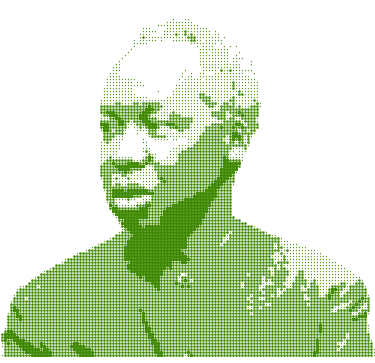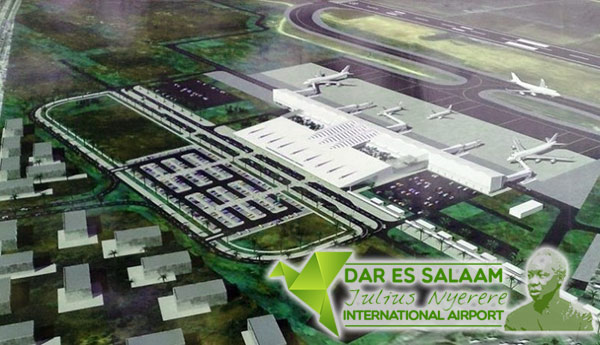
 Julius Nyerere International Airport (JNIA) is the largest and the busiest International Airport in Tanzania, located in Dar es Salaam, the largest city in Tanzania. Its international code (IATA code) is DAR. This is the one on your luggage labels when you take a flight to Tanzania. The airport is one of the 58 government owned airports and airstrips, operated, developed and managed by Tanzania Airports Authority (TAA). JNIA is about 12 kilometers (7.5 miles) southwest of the city. The airport was formally known as Dar es Salaam International Airport (DIA) before it was renamed in 2006 in honor of Julius Kambarage Nyerere (photo), the first President of the United Republic of Tanzania who died in 1999. The airport saves flights to and from different destinations including Africa, Europe and the Middle East. Currently there are two terminals, terminal 1 and terminal 2. The government is constructing terminal 3 which will be the largest terminal at JNIA with a capacity of handling up to 6,000,000 passengers annually.
Julius Nyerere International Airport (JNIA) is the largest and the busiest International Airport in Tanzania, located in Dar es Salaam, the largest city in Tanzania. Its international code (IATA code) is DAR. This is the one on your luggage labels when you take a flight to Tanzania. The airport is one of the 58 government owned airports and airstrips, operated, developed and managed by Tanzania Airports Authority (TAA). JNIA is about 12 kilometers (7.5 miles) southwest of the city. The airport was formally known as Dar es Salaam International Airport (DIA) before it was renamed in 2006 in honor of Julius Kambarage Nyerere (photo), the first President of the United Republic of Tanzania who died in 1999. The airport saves flights to and from different destinations including Africa, Europe and the Middle East. Currently there are two terminals, terminal 1 and terminal 2. The government is constructing terminal 3 which will be the largest terminal at JNIA with a capacity of handling up to 6,000,000 passengers annually.
The airport was developed during colonial period, and was later on moved to Kilwa Road near the National Stadium and changed its name to Mkeje Aerodrome. Mgulani Military Base area was also part of the airport area and until today if one can look carefully, pieces of the taxiway can be seen in this area.
Due to the development of the aviation industry in East Africa, the Dar-es-Salaam aerodrome has proved insufficient. Expansion of the aerodrome was also not possible because of unfavorable geographical features such as high altitude in the immediate vicinity, dense coconut vegetation and swampy terrain. In addition, a considerable number of people from the region had already settled around the airport. It was therefore decided to move the airport to a new location. Thus, Ukonga was chosen as the new location of the airfield.
Site clearing and construction commenced in 1951 and by October 1954 the airport was officially opened to business. This part of the airport is what is today Terminal 1 currently used for General Aviation.
In the early 80s plans to expand the aerodrome commenced and on October 1984 the airport was officially opened by the First Tanzania President - Mwalimu Julius K. Nyerere. The expansion involved the addition of infrastructure and facilities that increased its capacity to 1,500,000 passengers and 30,000 tons of cargo annually.
Given its favorable geographical location, with links to all other modes of transportation-sea, rail and road, the future outlook for JNIA for being the center of business for the region is ideal.
There are a number of investment opportunities that exist. The airport stands to harness all these opportunities in order to develop it to the level that will benefit the whole region.
As of February 2018, the construction of Terminal 3 which is expected to raise current passenger capacity at JNIA from 2.5 million to 9 million annually was decided the Tanzanian Minister of Works, Transport and Communications, Professor Makame Mbarawa.
Phase 1 of the scope of work comprises the construction of the main terminal building - facilitating 3.5 million annual passengers - including parking lots, access roads, platforms, and a taxiway. The design of the roof is inspired on the traditional sailing boats that can be found at the Dar es Salaam Coast. The new terminal 3 is designed (together with NACO, Netherlands Airport Consultants) for the anticipated growth of international air traffic, leaving the existing international Terminal 2 to cater for domestic flights. The second phase will then provide further capacity to facilitate 6 million annual passengers.

 |
The reception of departing and arriving travelers makes of Dar es Salaam International Airport one of the most modern in East Africa. Accessible sanitary facilities, shops, parkings, bars and air-conditioned halls allow passengers to wait for their flight in the best conditions. With a flight punctuality greater than 90%, the Dar es Salaam international airport will guarantee a seamless aerial experience ! |
 |
In order to facilitate your trip, we advise passengers to take all necessary measures to be in compliance with sanitary, custom and administrative requirements (passport, visa, etc..). |
Check the flight display board for arrivals and departures at the Dar es Salaam airport. Stay informed of delays and cancellations bookmarking this page :
 ] Air Tanzania returns to Entebbe International Airport after a decade > on Aug 28th 2018
] Air Tanzania returns to Entebbe International Airport after a decade > on Aug 28th 2018